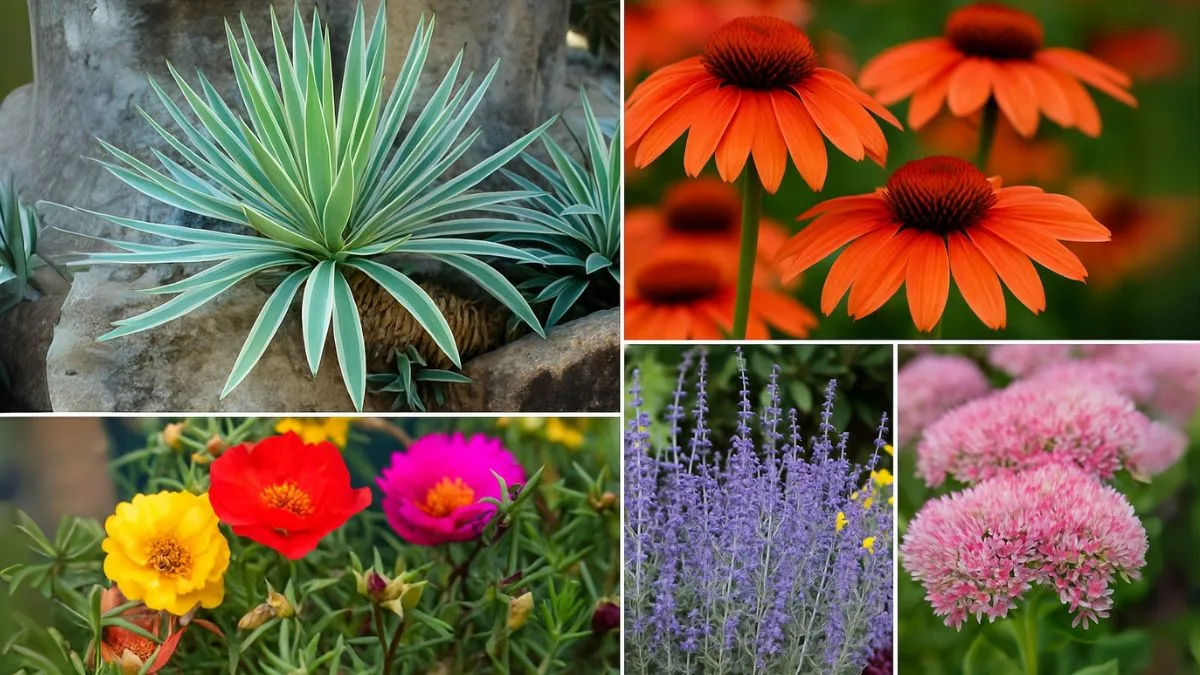Drought is no longer a problem limited to deserts—it’s becoming a global challenge. Gardeners across Canada, the USA, and many other parts of the world are now looking for ways to make their gardens thrive while conserving water. That’s where drought-resistant plants come into play.
Not only do they save water, but they also add texture, fragrance, and resilience to your garden. Whether you’re filling beds, creating borders, or looking for drought-tolerant ground covers, shrubs, and vines, these plants are both practical and beautiful.
Why Choose Drought-Resistant Plants?

- They conserve water while maintaining greenery.
- They are more resistant to pests and diseases.
- They thrive with minimal care once established.
- They add diversity and resilience to your garden design.
💡 Tip: Always remember that adding organic materials like compost can improve soil structure, allowing water to penetrate more deeply and stay available longer for plant roots.
1. Lavender
Lavender is a gardener’s dream. Its fragrant purple spikes are not just ornamental but also attract pollinators. This hardy plant thrives in full sun and well-drained soil, making it perfect for dry climates.
Care Tip: Prune after flowering to encourage new growth. Lavender is also excellent for borders and pathways, where its fragrance can be enjoyed up close.
Also Read: 5 Gorgeous Lavender Varieties That Bring Relaxation and Aroma
2. Succulents
When you think of drought resistance, succulents instantly come to mind. From aloe to echeveria, they store water in their fleshy leaves, making them perfect for water-scarce regions.
Personal Experience: I once left my potted succulents unattended for three weeks during summer, and they looked as fresh as ever when I returned. These truly are the ultimate low-maintenance plants.
Also Read: 5 Stunning Succulents That Can Survive Snow & Frost
3. Agave
Agave plants are architectural masterpieces. With spiky rosettes and dramatic silhouettes, they bring structure to any landscape. Their thick leaves store water, ensuring survival through long dry spells.
Garden Use: Agave pairs beautifully with rocks and gravel, making it ideal for xeriscaping.
4. Coneflower (Echinacea)
Coneflowers are hardy perennials known for their daisy-like blooms. They come in pink, purple, and white, and are excellent for attracting butterflies and bees.
Bonus: Coneflower roots are used in herbal remedies, making this plant both beautiful and beneficial.
5. Russian Sage
With its airy lavender-blue flowers and silvery foliage, Russian Sage adds elegance to any dry landscape. It thrives in poor soils and needs minimal maintenance once established.
Pro Tip: Plant it in groups for a dramatic effect, as its soft texture contrasts beautifully with bold succulents and agave.
6. Yarrow
Yarrow is a must-have for water-smart gardens. With clusters of yellow, red, or pink blooms, it’s both colorful and drought-tolerant.
Care Tip: It thrives in poor soils and needs little fertilizer. Plus, its feathery foliage adds a soft texture to garden beds.
Also Read: Yarrow: Nature’s Hidden Healing Herb
7. Yucca
Few plants match the toughness of Yucca plants. Known for their sword-like leaves and dramatic flower spikes, Yucca plants are tough and resilient, tolerating poor soil and harsh sun.
Personal Note: In my own garden, I planted yucca near a sun-drenched fence where nothing else survived. Not only did it thrive, but it also bloomed magnificently in its second year.
Also Read: 5 Stunning Yucca Plants to Elevate Your Indoor Garden
8. Portulaca (Moss Rose)
For a pop of vibrant color, Portulaca is unbeatable. Its small, succulent-like leaves retain water, and its cheerful flowers bloom in a rainbow of shades.
Garden Use: Works brilliantly as a drought-tolerant ground cover, spreading quickly to fill gaps in sunny areas.
9. Rosemary
This herb is not only delicious in the kitchen but also thrives in dry gardens. Rosemary’s needle-like leaves are adapted to conserve water, making it drought-tolerant and fragrant.
Bonus Tip: Plant rosemary near your patio so you can snip fresh sprigs while cooking.
Also Read: From Tea to Skincare: 8 Brilliant Ways to Use Rosemary Flowers
10. Sedum (Stonecrop)
Sedum varieties are famous for their fleshy leaves and clusters of star-shaped flowers. They grow well in rocky soils and need almost no care once established.
Garden Use: Sedum is ideal for rock gardens, green roofs, and container plantings.
Table: Quick Guide to Drought-Resistant Plants
Plant |
Height |
Best Use |
Special Benefit |
Lavender |
1-3 ft |
Borders, pots |
Fragrance, pollinator magnet |
Succulents |
Varies |
Containers, ground cover |
Low-maintenance, diverse shapes |
Agave |
2-6 ft |
Rock gardens, focal point |
Architectural beauty |
Coneflower |
2-4 ft |
Beds, wildflower gardens |
Herbal benefits |
Russian Sage |
3-5 ft |
Group plantings |
Silvery foliage, airy blooms |
Yarrow |
1-2 ft |
Beds, borders |
Attracts pollinators |
Yucca |
2-6 ft |
Accent plant |
Hardy, dramatic blooms |
Portulaca |
6-8 in |
Ground cover |
Bright, cheerful flowers |
Rosemary |
1-4 ft |
Herb gardens, pots |
Culinary + ornamental use |
Sedum |
6 in–2 ft |
Rock gardens, roofs |
Thrives in poor soil |
Tips for Planting Drought-Resistant Gardens
- Add compost: Remember that adding organic materials like compost can improve soil structure and help retain moisture.
- Water deeply but less often: This encourages roots to grow deeper.
- Choose local species: Native plants are naturally adapted to regional conditions.
- Group plants by water needs: Place drought-lovers together for easier maintenance.
- Use mulch: Helps lock in soil moisture and reduce evaporation.
Creating a drought-resistant garden doesn’t mean sacrificing beauty. With plants like Lavender, Succulents, Agave, Coneflower, Russian Sage, Yarrow, Yucca, Portulaca, Rosemary, and Sedum, you can design a vibrant, water-smart space that flourishes with minimal effort.
Whether you’re battling dry summers in the USA or unpredictable climates in Canada, these plants will bring resilience, color, and life to your garden. Start small, experiment, and watch how these water-wise wonders transform your outdoor space.






